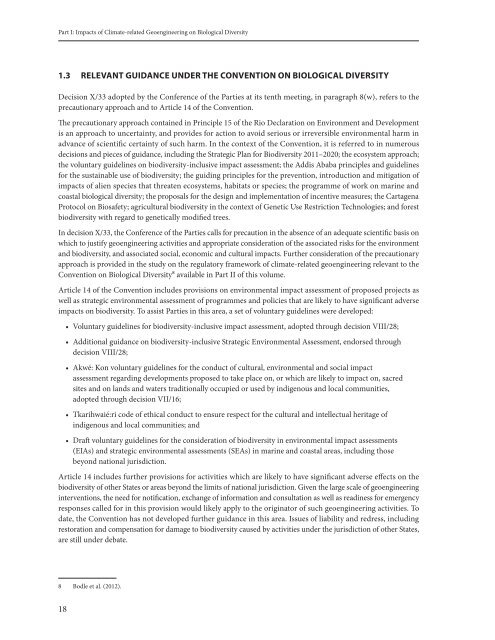cbd-ts-66-en
cbd-ts-66-en
cbd-ts-66-en
You also want an ePaper? Increase the reach of your titles
YUMPU automatically turns print PDFs into web optimized ePapers that Google loves.
Part I: Impac<strong>ts</strong> of Climate-related Geo<strong>en</strong>gineering on Biological Diversity<br />
1.3 RELEVANT GUIDANCE UNDER THE CONVENTION ON BIOLOGICAL DIVERSITY<br />
Decision X/33 adopted by the Confer<strong>en</strong>ce of the Parties at i<strong>ts</strong> t<strong>en</strong>th meeting, in paragraph 8(w), refers to the<br />
precautionary approach and to Article 14 of the Conv<strong>en</strong>tion.<br />
The precautionary approach contained in Principle 15 of the Rio Declaration on Environm<strong>en</strong>t and Developm<strong>en</strong>t<br />
is an approach to uncertainty, and provides for action to avoid serious or irreversible <strong>en</strong>vironm<strong>en</strong>tal harm in<br />
advance of sci<strong>en</strong>tific certainty of such harm. In the context of the Conv<strong>en</strong>tion, it is referred to in numerous<br />
decisions and pieces of guidance, including the Strategic Plan for Biodiversity 2011–2020; the ecosystem approach;<br />
the voluntary guidelines on biodiversity-inclusive impact assessm<strong>en</strong>t; the Addis Ababa principles and guidelines<br />
for the sustainable use of biodiversity; the guiding principles for the prev<strong>en</strong>tion, introduction and mitigation of<br />
impac<strong>ts</strong> of ali<strong>en</strong> species that threat<strong>en</strong> ecosystems, habita<strong>ts</strong> or species; the programme of work on marine and<br />
coastal biological diversity; the proposals for the design and implem<strong>en</strong>tation of inc<strong>en</strong>tive measures; the Cartag<strong>en</strong>a<br />
Protocol on Biosafety; agricultural biodiversity in the context of G<strong>en</strong>etic Use Restriction Technologies; and forest<br />
biodiversity with regard to g<strong>en</strong>etically modified trees.<br />
In decision X/33, the Confer<strong>en</strong>ce of the Parties calls for precaution in the abs<strong>en</strong>ce of an adequate sci<strong>en</strong>tific basis on<br />
which to justify geo<strong>en</strong>gineering activities and appropriate consideration of the associated risks for the <strong>en</strong>vironm<strong>en</strong>t<br />
and biodiversity, and associated social, economic and cultural impac<strong>ts</strong>. Further consideration of the precautionary<br />
approach is provided in the study on the regulatory framework of climate-related geo<strong>en</strong>gineering relevant to the<br />
Conv<strong>en</strong>tion on Biological Diversity8 available in Part II of this volume.<br />
Article 14 of the Conv<strong>en</strong>tion includes provisions on <strong>en</strong>vironm<strong>en</strong>tal impact assessm<strong>en</strong>t of proposed projec<strong>ts</strong> as<br />
well as strategic <strong>en</strong>vironm<strong>en</strong>tal assessm<strong>en</strong>t of programmes and policies that are likely to have significant adverse<br />
impac<strong>ts</strong> on biodiversity. To assist Parties in this area, a set of voluntary guidelines were developed:<br />
18<br />
• Voluntary guidelines for biodiversity-inclusive impact assessm<strong>en</strong>t, adopted through decision VIII/28;<br />
• Additional guidance on biodiversity-inclusive Strategic Environm<strong>en</strong>tal Assessm<strong>en</strong>t, <strong>en</strong>dorsed through<br />
decision VIII/28;<br />
• Akwé: Kon voluntary guidelines for the conduct of cultural, <strong>en</strong>vironm<strong>en</strong>tal and social impact<br />
assessm<strong>en</strong>t regarding developm<strong>en</strong><strong>ts</strong> proposed to take place on, or which are likely to impact on, sacred<br />
sites and on lands and waters traditionally occupied or used by indig<strong>en</strong>ous and local communities,<br />
adopted through decision VII/16;<br />
• Tkarihwaié:ri code of ethical conduct to <strong>en</strong>sure respect for the cultural and intellectual heritage of<br />
indig<strong>en</strong>ous and local communities; and<br />
• Draft voluntary guidelines for the consideration of biodiversity in <strong>en</strong>vironm<strong>en</strong>tal impact assessm<strong>en</strong><strong>ts</strong><br />
(EIAs) and strategic <strong>en</strong>vironm<strong>en</strong>tal assessm<strong>en</strong><strong>ts</strong> (SEAs) in marine and coastal areas, including those<br />
beyond national jurisdiction.<br />
Article 14 includes further provisions for activities which are likely to have significant adverse effec<strong>ts</strong> on the<br />
biodiversity of other States or areas beyond the limi<strong>ts</strong> of national jurisdiction. Giv<strong>en</strong> the large scale of geo<strong>en</strong>gineering<br />
interv<strong>en</strong>tions, the need for notification, exchange of information and consultation as well as readiness for emerg<strong>en</strong>cy<br />
responses called for in this provision would likely apply to the originator of such geo<strong>en</strong>gineering activities. To<br />
date, the Conv<strong>en</strong>tion has not developed further guidance in this area. Issues of liability and redress, including<br />
restoration and comp<strong>en</strong>sation for damage to biodiversity caused by activities under the jurisdiction of other States,<br />
are still under debate.<br />
8 Bodle et al. (2012).


